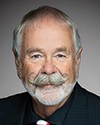I'll start with our operating employees. They are very talented, well trained, well motivated. They know their jobs extremely well. I've had the pleasure of working with many of them myself.
But they are humans, and humans make mistakes. Furthermore, things such as electronic devices are, I would argue, a problem in society. You see that in society today. Their use is a strong detractor from safe behaviour. Certainly in the railroad operating environment, we have rules and procedures that say they must be turned off, stowed, and not on their person; we simply do not allow them in the environment. Without a means to actually monitor on an ad hoc basis, however, we have really no ability to know that this rule, this procedure, is actually being followed.
That's just one example.



